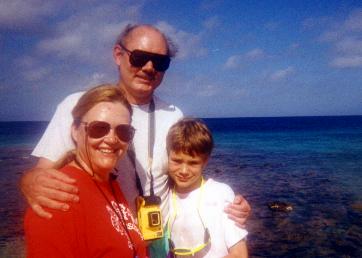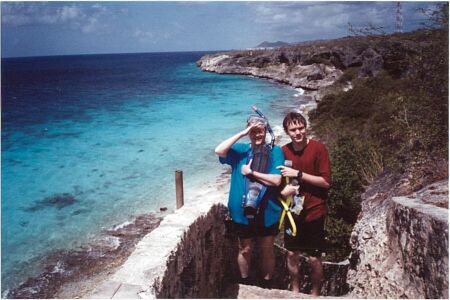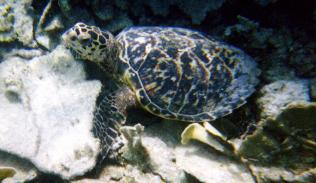Bonaire: Water Paradise of the Netherlands Antilles: A Trip Report by Richard W. Slatta
Original report August 1997, updated with new pictures 25 June 1998, updated with very sad news 20 Mar 2002. Redesigned with links to our new Caribbean Snorkeling Links Page
 [Photos by the author and family] Bonaire is a chunk of limestone, coral,
and a little sand sitting about 50 miles off Venezuela's northern coast. Smack
in the trade wind belt, it enjoys steady winds from the east that temper the
otherwise hot and dry climate. Its closest island neighbors are Curacao and
Aruba, also settled by the Dutch. The photo shows Maxine and JD at 1000 Steps
dive site. It's gorgeous and still well worth snorkeling. And there are no
where near 1000 steps to get to it!
[Photos by the author and family] Bonaire is a chunk of limestone, coral,
and a little sand sitting about 50 miles off Venezuela's northern coast. Smack
in the trade wind belt, it enjoys steady winds from the east that temper the
otherwise hot and dry climate. Its closest island neighbors are Curacao and
Aruba, also settled by the Dutch. The photo shows Maxine and JD at 1000 Steps
dive site. It's gorgeous and still well worth snorkeling. And there are no
where near 1000 steps to get to it!  Now,
the very sad news for snorklers. A renegade storm named Lenny lashed the west
coast of Bonaire and Klein (Little) Bonaire in November 1999. The vicious
waves destroyed all corals above the depth of 20-30 feet. Thus the magnificent
stands of elkhorn, staghorn, brain corals, sea fans, and other shallow corals
are gone. In almost all areas, all you will find is sand and coral debris.
The pictures here are from the "good old" pre-Lenny days. In a single day,
Bonaire changed from the best snorkeling spot in the Caribbean to a site hardly
worth visiting. The only snorkeling sites worth your time are 18 Palms (off
the Plaza Resort) and the short stretch from Andrea II north to Ol' Blue.
Diving at deeper depths remains a good option, but snorkelers should look
for other islands.
Now,
the very sad news for snorklers. A renegade storm named Lenny lashed the west
coast of Bonaire and Klein (Little) Bonaire in November 1999. The vicious
waves destroyed all corals above the depth of 20-30 feet. Thus the magnificent
stands of elkhorn, staghorn, brain corals, sea fans, and other shallow corals
are gone. In almost all areas, all you will find is sand and coral debris.
The pictures here are from the "good old" pre-Lenny days. In a single day,
Bonaire changed from the best snorkeling spot in the Caribbean to a site hardly
worth visiting. The only snorkeling sites worth your time are 18 Palms (off
the Plaza Resort) and the short stretch from Andrea II north to Ol' Blue.
Diving at deeper depths remains a good option, but snorkelers should look
for other islands.
 JD Slatta also enjoys the wonders under the Caribbean Sea.
JD Slatta also enjoys the wonders under the Caribbean Sea.
 If
you get a chance and love the sea--and wild landscapes-- don't miss Bonaire!
It's a powerful, wonderous testimonial to the importance and power of wise
conservation of resources. You'll find good information about the island
on the Internet. Just use any search engine and look for "Bonaire." Just
remember that, while fish abound, the massive corals near the shoreline
are mostly gone. Check out Bonaire's colorful,
fascinating history.
If
you get a chance and love the sea--and wild landscapes-- don't miss Bonaire!
It's a powerful, wonderous testimonial to the importance and power of wise
conservation of resources. You'll find good information about the island
on the Internet. Just use any search engine and look for "Bonaire." Just
remember that, while fish abound, the massive corals near the shoreline
are mostly gone. Check out Bonaire's colorful,
fascinating history.